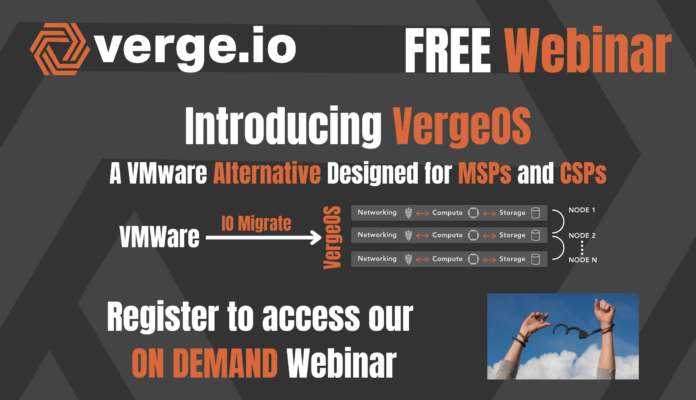While rising licensing fees and uncertainty about product direction are big worries, MSPs need more than just a VMware alternative to stay competitive in the future. Regardless of their business model (providing IT services to customers with on-premises hardware or providing infrastructure for customers to host their applications), they require features that exceed those found in VMware vSphere’s enterprise versions.
Out of the gate, assuming that licensing costs are a common concern, VergeIO will be able to help both MSPs and their clients get costs under control and more affordable.
IT as Service Provider Requirements
A collection of service providers offer IT services to customers who have on-premises equipment. The service provider may also sell the customer hardware and software or take over support for existing solutions. They may supply entire IT services or supplement current IT professionals. These clients are most likely upset about VMware’s latest modifications and seeking an alternative. However, these MSPs require more than a VMware alternative that can reduce costs. They need a system that makes it easy to support dozens, if not hundreds, of remote consumers.
These providers frequently serve small to medium-sized enterprises (SMBs) with only two or three servers. These customers frequently have little, if any, space dedicated to a data center. Combining functions into a single “pod” saves space, reduces the likelihood of error, and simplifies remote administration.
They may also seek a solution that allows them to move beyond IT as a Service. An obvious next step for many IT as a Service providers is to provide Disaster Recovery as a Service. The issue is that, when compared to legacy solutions, DRaaS is expensive, complex to deploy, and difficult to implement recovery during a disaster.
VergeIO for IT Service Providers
VergeIO can help IT service provider firms in a variety of ways. First and foremost, VergeOS provides a seamless transfer from VMware to VergeOS. Second, in many cases, it can use the customer’s existing server hardware, making the transfer to the new platform seamless.
Third, and specifically for IT as a service provider, VergeOS has an integrated site management capabilities. There is no additional software to purchase or virtual machines to set up. Site Manager communicates to remote locations via a mesh framework, ensuring that there is no single point of management failure. Administrators may swiftly and remotely connect into any provider’s customers and manage the complete client environment as if they were physically present.
Fourth, VergeOS integrates storage and network functions into its main software. It removes the need for an external, dedicated storage array. It also provides firewall, routing, and other network services, which eliminates the need for these equipment. Most enterprises with small data centers may use VergeOS to handle all of their infrastructure requirements on two or three servers.
Fifth, VergeOS’ multi-tenant virtual data center (VDC) technology paves the way for the company to provide disaster recovery as a service (DRaaS) capabilities. Providers can set up one or more VDCs at their supported client sites and then duplicate them as a single object to the provider’s data center. VDCs make it simple to execute DR tests on a regular basis, ensuring successful disaster recovery.
Infrastructure as a Service Provider Requirements
Another category of MSPs offers infrastructure as a service to their customers. These clients often have little, if any, on-premises hardware and rely on the provider’s data center, paying for physical resources on a periodic basis. License pricing is also an issue for these providers because it affects the competitive pricing they can deliver to their clients. Again, these MSPs require more than a VMware alternative. First, they control the hardware, thus they want infrastructure software that can leverage commodity off-the-shelf technology while outperforming name-brand solutions.
These providers may also benefit from a more adaptable VMware solution. One that not only operates on existing hardware but also allows them to combine different types of hardware to maximize the system’s lifespan. They also want an infrastructure software solution that allows them to quickly scale up to onboard new clients and respond to unanticipated demand from existing customers.
An outage may affect dozens, if not hundreds, of clients. They require a solution that does more than defend against a single point of failure. They require one that can provide several points of redundancy, so that even if multiple drives or servers fail, clients do not experience prolonged disruptions.
They can benefit from the same multi-tenancy capabilities outlined above. Multi-tenancy allows them to share the same hardware with multiple customers while keeping data isolated. It allows them to address each customer’s specific needs without having to construct silos based on the use case.
VergeIO for IaaS providers
The VergeOS software is more efficient than VMware. Most customers claim that with the same hardware, compute efficiency and storage performance are more than 25% higher. This efficiency breathes fresh life into the provider’s existing hardware investment, allowing them to accommodate more clients without purchasing additional hardware.
As these providers grow, they benefit from VergeOS’ hardware flexibility. They can combine servers from various vendors, CPU generations, and storage configurations in the single VergeOS instance. Our service-based licensing is especially appealing to these providers because it allows them to scale employing very dense, high CPU and core count server configurations without incurring software license penalties.
Outages are especially severe for Infrastructure as a Service providers since they affect a large number of customers. While the majority of infrastructure software provides rudimentary hardware failure protection, resiliency is sometimes restricted to one or two disks or servers. To maintain the highest possible performance profile, the program may dynamically transition and load balance virtual machine movements to other cluster nodes. VergeOS goes beyond providing a single point of failure to provide several points of redundancy using ioGuardian. It enables real-time, in-line data recovery even when several disks or servers fail. It is built into the product at no extra cost.
VergeOS’ snapshot technology, ioClone, guards against “soft errors” and user blunders. Traditional snapshot technique manipulates inode or file allocation tables. This results in an interdependent chain of pseudo-copies that do not meet the 3-2-1 backup criteria. ioClone takes snapshots using VergeOS’s integrated global inline deduplication features. The ultimate result is an independent replica of data that takes a nanosecond to make, requires no additional capacity, can be stored eternally, and can be retrieved instantaneously.
Finally, infrastructure as a service. VergeOS’ integrated multi-tenant virtual data centers (VDCs) can provide considerable benefits to providers. For example, each customer can be assigned to a specific VDC. Even though they share hardware, each VDC is isolated, and if one fails, the others remain secure. VDCs can also be nested. A customer may have both a production environment and testing and development sub-VDCs. Each VDC can have a distinct network and storage setup. Providers can also assign unique hardware to specific tenants in order to suit the needs of various customer service levels.
Conclusion
In a world characterized by escalating licensing fees and uncertainty about product direction, MSPs truly require more than the usual VMware option. Beyond conventional hypervisor solutions, IT and Infrastructure as a Service Providers have specific requirements. VergeIO is a reliable choice that not only meets these diverse requirements, but also improves service delivery and efficiency.
VergeOS for IT as a Service Providers provides a simple transfer from VMware, interoperability with existing hardware, and integrated management features. These capabilities ease remote client assistance and open the door for sophisticated services such as DRaaS, making it a tempting option for MSPs eager to extend their offerings while remaining cost-effective.
Infrastructure as a Service providers benefit from VergeIO’s high efficiency and flexibility. VergeOS assures that providers can give their clients with high availability and robust performance by improving compute and storage performance, hardware flexibility, and greater resilience via many points of redundancy. Multi-tenant VDCs provide the essential separation and customization, allowing MSPs to meet various customer needs without the complexities of siloed systems.
Finally, VergeIO provides a holistic solution that supports MSPs’ increasing demands, allowing them to remain competitive in an increasingly competitive market. VergeIO enables providers to expand their service capabilities, operational efficiency, and customer satisfaction by providing more and better for less.
Take action to know what you may not know!
Sign up to view a 45-minute deep dive recorded session into how the VergeIO will work in your environment.
Download our white paper “Addressing the Top MSP Challenges”. For a series of whiteboard deep-dives into the VergeOS architecture, please check out this playlist (updated weekly): https://www.youtube.com/playlist?list=PLohMEYYJuefzzkhh0x9q2rhKUD1awlRzB













